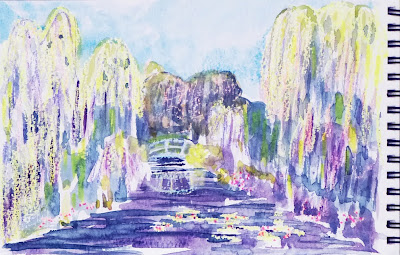 |
| (click on image to enlarge) |
Giverny
Watercolour and crayon sketch
©2013 Charlene Brown
The mid-19th century invention of the camera lead
to both an examination of Euclid’s
assumptions about space, and science’s hold on the paradigms of art.
And more
specifically, after a few years, on the hold of the Academy des Beaux Arts on
the artists of the time. Their rules of perfection and suitable content
resulted in the rejection of the paintings of a new movement whom the Academy
called Impressionists – and they weren’t smiling when they called them that,
claiming that their paintings were merely illogical impressions of art, rather
than the real thing with proper perspective.
In the 20th century, these ‘impressionistic’
visualizations came to be regarded by scholars (clearly not members of the
Academy des Beaux Arts) as prescient to Einstein’s Special Theory of
Relativity, of all things. I will work through that concept as soon as I can…









